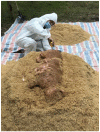Static Aerated Composting of African Swine Fever Virus-Infected Swine Carcasses with Rice Hulls and Sawdust
- PMID: 37242391
- PMCID: PMC10222418
- DOI: 10.3390/pathogens12050721
Static Aerated Composting of African Swine Fever Virus-Infected Swine Carcasses with Rice Hulls and Sawdust
Abstract
Identifying and ensuring the inactivation of the African Swine Fever virus in deadstock is a gap in the swine industry's knowledge and response capabilities. The results of our study demonstrate that ASFv in deadstock was inactivated using static aerated composting as the carcass disposal method. Replicated compost piles with whole market hogs and two different carbon sources were constructed. In-situ bags containing ASFv-infected spleen tissue were placed alongside each of the carcasses and throughout the pile. The bags were extracted at days 0, 1, 3, 7, 14, 28, 56, and 144 for ASFv detection and isolation. Real-time PCR results showed that DNA of ASFv was detected in all samples tested on day 28. The virus concentration identified through virus isolation was found to be below the detection limit by day 3 in rice hulls and by day 7 in sawdust. Given the slope of the decay, near-zero concentration with 99.9% confidence occurred at 5.0 days in rice hulls and at 6.4 days in sawdust. Additionally, the result of virus isolation also showed that the virus in bone marrow samples collected at 28 days was inactivated.
Keywords: African Swine Fever virus; carcass management; compost; inactivation.
Conflict of interest statement
The authors have no conflict to declare.
Figures








References
-
- Guan J., Chan M., Grenier C., Wilkie D.C., Brooks B.W., Spencer J.L. Survival of Avian Influenza and Newcastle Disease Viruses in Compost and at Ambient Temperatures Based on Virus Isolation and Real-Time Reverse Transcriptase PCR. Avian Dis. Dig. 2009;53:26–33. doi: 10.1637/8381-062008-Reg.1. - DOI - PubMed
-
- Kim S., Kwon H., Park S., Jeon H., Park J., Park J. Pilot-Scale Bio-Augmented Aerobic Composting of Excavated Foot-And-Mouth Disease Carcasses. Sustainability. 2017;9:445. doi: 10.3390/su9030445. - DOI
Grants and funding
LinkOut - more resources
Full Text Sources
Miscellaneous

